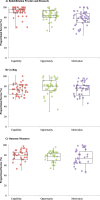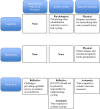Therapist perceptions of a rehabilitation research study in the intensive care unit: a trinational survey assessing barriers and facilitators to implementing the CYCLE pilot randomized clinical trial
- PMID: 31741746
- PMCID: PMC6849178
- DOI: 10.1186/s40814-019-0509-3
Therapist perceptions of a rehabilitation research study in the intensive care unit: a trinational survey assessing barriers and facilitators to implementing the CYCLE pilot randomized clinical trial
Abstract
Background: Rehabilitation interventions, including novel technologies such as in-bed cycling, could reduce critical illness-associated morbidity. Frontline intensive care unit (ICU) therapists often implement these interventions; however, little is known about their perceptions of engaging in clinical research evaluating these technologies.
Objective: To understand frontline therapist perceptions of barriers and facilitators to implementing a pilot randomized controlled trial (RCT) of early in-bed cycling with mechanically ventilated patients in the ICU and outcome measures (CYCLE Pilot RCT; NCT02377830).
Methods: We developed a 115-item, self-administered, electronic survey informed by 2 complementary knowledge translation (KT) models: the Capability-Opportunity-Motivation-Behaviour (COM-B) system and the Theoretical Domains Framework (TDF). We included demographics and 3 sections: Rehabilitation Practice and Research, Cycling, and Physical Outcome Measures. Each section contained items related to the COM-B system and TDF domains. Item formats included 7-point Likert-type scale questions (1 = strongly disagree, 7 = strongly agree) and free-text responses. We invited therapists (physiotherapists, occupational therapists, and therapy assistants) who participated in the international, multi-center, CYCLE Pilot RCT to complete this cross-sectional survey. We descriptively analyzed results by survey section, COM-B attribute, TDF domain, and individual question within and across sections. We identified barriers based on items with median scores < 4/7.
Results: Our response rate was 85% (45/53). Respondents were from Canada (67%), the USA (21%), and Australia (11%). The majority had a physiotherapy background (87%) and previous research experience (87%). By section, Rehabilitation Practice and Research (85%; 95% confidence interval (CI) [82%, 87%]) was higher than Cycling (77%; 95% CI [73%, 80%]) and Outcome Measures (78%; 95% CI [75%, 82%]). Across the 3 sections, Motivation was lower than Capability and Opportunity. The most common Motivation barrier was the emotion TDF domain, related to the time required to conduct cycling and outcome measures (median [1st, 3rd quartiles] 3/7 [2, 6]).
Conclusions: Frontline ICU therapists had positive perceptions of research engagement. However, we identified barriers related to Motivation, and concerns regarding time to implement the research protocol. Our results can inform specific KT strategies to engage frontline ICU therapists and optimize protocol implementation in critical care rehabilitation research.
Keywords: Knowledge translation; Physical therapists; Questionnaire; Rehabilitation.
© The Author(s). 2019.
Conflict of interest statement
Competing interestsThree of the RT300 in-bed cycle ergometers used for the CYCLE Pilot RCT were loaned to Michelle Kho by Restorative Therapies. Restorative Therapies had no role in the study design, data collection and analysis, decision to publish, or preparation of the manuscript.
Figures




References
Associated data
LinkOut - more resources
Full Text Sources
Medical

